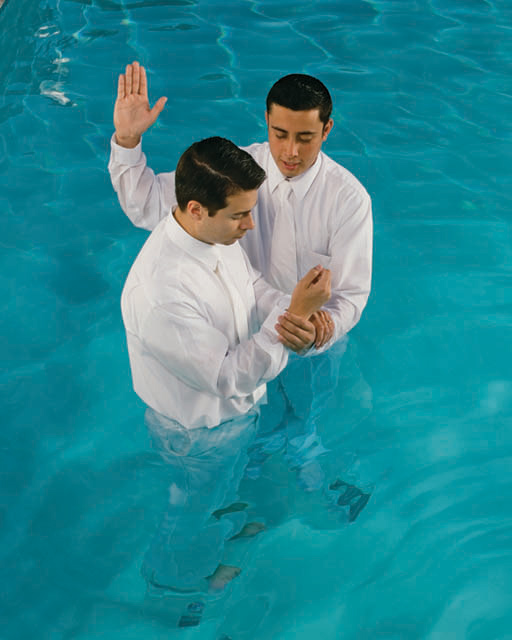Mormon Baptism
The Book of Mormon also teaches about the importance of baptism. In the Book of Mormon there is an account of Jesus’ appearance to the Nephites after His resurrection. On that occasion, Jesus taught the people about the necessity of faith, repentance, baptism, and the gift of the Holy Ghost (see First Principles of the Gospel). He then authorized twelve disciples to baptize (see 3 Nephi 11:18–41 and 19:11–13) in His name. The Book of Mormon is an important source to understand how a proper baptism should be performed (see baptismal prayer in 3 Nephi 11:23–28 and Moroni 6:1–4).
The fourth Article of Faith of The Church of Jesus Christ of Latter-day Saints (sometimes called the Mormon Church) states that "baptism by immersion for the remission of sins" is one of the "first principles and ordinances of the Gospel." Latter-day Saints believe, as do many other Christians, that baptism is an essential step and ordinance for all people who want to join the Church.
A proper baptism should follow certain preliminary steps, namely faith and repentance. It should be followed by the so-called “baptism of fire” or the laying on of hands (by someone with priesthood authority) to bestow the Gift of the Holy Ghost. Boyd K. Packer, an apostle of The Church of Jesus Christ of Latter-day Saints, said the following: "another verse teaches that this will come 'if it so be that ye believe in Christ, and are baptized, first with water, then with fire and with the Holy Ghost, following the example of our Savior' (Mormon 7:10). Again, there are two parts to baptism—baptism by water and baptism by fire or the Holy Ghost. If you separate the two, as the Prophet Joseph Smith said, it is but half a baptism."(Liahona, 2006, 18–24)
Baptism requires a commitment to keep God’s commandments until the end of mortal life and to be a witness for Christ. When people are properly baptized they receive remission of their sins and, if they then endure to the end, they will gain access to the Celestial Kingdom and to eternal life (see Mark 16:15–16 in the Bible or 2 Nephi 31:13-21 in the Book of Mormon).
Baptism is an essential part of our Father in Heaven’s plan for us. He actually commands us to be baptized by immersion to show that we believe in Jesus Christ, that we love Him, and that we want to follow Him by obeying His commandments.
In the Church of Jesus Christ it is taught that every person who reaches the age of eight, and who is able to understand what is right and what is wrong, should be baptized. Children who are younger than eight years old, or people who are mentally incapable of understanding what is right and wrong, do not need this ordinance to be saved in God’s kingdom and are covered by Christ's Atonement.
A baptism in the Church of Jesus Christ is done by placing the person completely under the water and by raising him or her up again out of the water. A baptism can be only performed by a person who has the proper authority. For example, John the Baptist had the priesthood authority necessary to baptize Jesus and others in his time. The priesthood holder raises his right hand, recites the prescribed baptismal prayer, and then fully immerses the candidate in the water (see 3 Nephi 11:23–26).
Baptism is a necessary but also symbolic ordinance. It symbolizes the covenant by which a new convert promises to become a follower of Jesus Christ, to take upon him or her the name of the Savior, to stand as a witness of God, and to keep His commandments. Also, the new convert accepts to serve God and his or her fellow servants to the end. The Lord Jesus promises to pour out His spirit upon the new convert, redeem him or her from their sins, and give them eternal life (see Mosiah 18:7–10).
The symbolism involved in the baptism invites new converts and others observing the ordinance to reflect on its meanings. More specifically, the burial in the water and the subsequent arising out of the water symbolize the new convert's faith in the resurrection of Jesus Christ and of all people. Moreover, it represents a new birth to a life in Christ, a life that will be centered in following God’s commandments.
Acceptance of Other Churches' Baptisms
The Church of Jesus Christ of Latter-day Saints does not recognize baptisms performed in other churches. This is for two reasons: (1) because of the emphasis upon the proper authority being necessary for baptism (see above) and (2) because of the function of baptism as the formal entry into the Latter-day Saints community as well as the symbolic entering into a covenant with Christ.
There are many churches that regularly recognize and accept baptisms performed by Christians other than their own ministers, and some of these accept Latter-day Saints baptisms as valid. For example, the churches of the Anglican community accept Mormon baptisms; the Roman Catholic Church, by contrast, does not.
